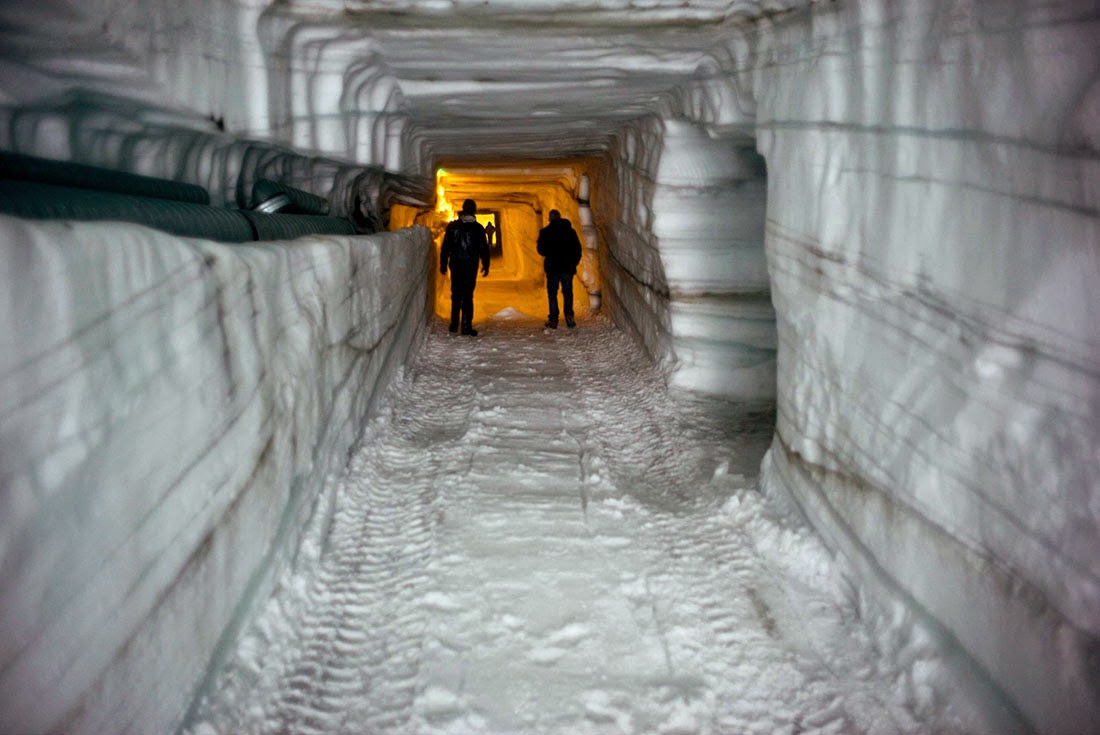 [Image: Courtesy of Icecave Iceland].
[Image: Courtesy of Icecave Iceland].
There’s an interesting construction/excavation project going on over in Iceland right now: an artificial tunnel and cave complex being dug into the Langjökull Glacier.
When complete, the publicly accessible infra-glacial facility “will consist of numerous nooks and dens which will house exhibitions, information, restaurants and even a small chapel for those who would like to marry deep within an ice cap.”
Bringing tourists nearly 100 feet below the surface of the glacier, the structure is expected to become semi-permanent, lasting through the summer months for years to come.
 [Image: Courtesy of Icecave Iceland].
[Image: Courtesy of Icecave Iceland].
The so-called “Icecave” is set to open later this year, and is not far from Reykjavik; for now, its entrance consists only of some understated plywood framing, with no real indication of what awaits below—or within, as the case may be.
 [Image: Courtesy of Icecave Iceland].
[Image: Courtesy of Icecave Iceland].
But tunnels, bays, and side chambers are currently under construction, being chipped down by excavation equipment and drills, and then further shaped by hand tools.
 [Image: Courtesy of Icecave Iceland].
[Image: Courtesy of Icecave Iceland].
I love the idea that all of this is essentially doomed—that the chambers will eventually collapse or melt, even if only decades from now, and that the glacier itself will presumably someday refreeze, free of all these spatial abnormalities.
At which point, the architecture of subtraction could simply start all over again, like a 3-dimensional Etch-a-Sketch of brand new ramps, tunnels, and stairs, all burrowing down toward bedrock. A ritually renewed space, a kind of negative Ise Shrine in the ice.
Or perhaps we need a Mole Man of the Glacier.
In any case, lights are now being installed in the walls, giving the place an otherworldly glow that comes from within the structure itself—
 [Image: Courtesy of Icecave Iceland].
[Image: Courtesy of Icecave Iceland].
—with the truly awesome effect that nearby rooms will seem to glow through the ice walls, revealing themselves as illuminated shapes, even appearing to shine through the floors and ceilings.
This same strategy, using frosted glass floors, walls, and ceilings, in a building otherwise made from dark-stained timber or masonry, would be beautiful.

 [Images: Courtesy of Icecave Iceland].
[Images: Courtesy of Icecave Iceland].
Meanwhile, huge ducts like something out of a frozen warehouse or sub-glacial military base criss-cross the frozen ceilings and extend deeper into the glacier.
 [Image: Courtesy of Icecave Iceland].
[Image: Courtesy of Icecave Iceland].
Indeed, I’m reminded of the incredible story of Camp Century—or Project Iceworm—a U.S. military city built under the ice of northwestern Greenland. Here’s a video about it, if you’re curious:
As explored on BLDGBLOG back in 2011, Camp Century was a sprawling complex of prefabricated architectural units and steel arches installed within the ice cap, and, astonishingly, it was powered by a portable nuclear reactor.

 [Images: Camp Century under construction; photographs via Frank J. Leskovitz].
[Images: Camp Century under construction; photographs via Frank J. Leskovitz].
In any case, the Langjökull excavations are meant to finish up later this year; check back on the Icecave homepage for its opening date.

Reminds me of the 'Underground' Martian town of Zygote in Kim Stanley Robinson's Green Mars. Built into the southern ice cap and powered by a small nuclear reactor.